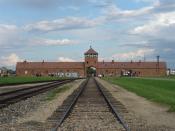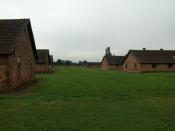Auschwitz, located in Poland, was Germany's largest and most horrendous concentration camp. It was established by order of Heinrich Himler on April 27, 1940. At first, it was small because it was a work camp for Polish and Soviet prisoners of war. It became a death camp in 1941. The reasons for the epidemics and contagious diseases that prevailed in Auschwitz concentration camp included the dreadful living conditions, which varied during the years that the camp in operation, and were different in each part of the camp. In Auschwitz I, prisoners lived in old brick barracks. Several hundred three-tier wooden bunk beds were installed in each building. The overcrowding in Auschwitz I forced basements and lofts into use as living quarters.
Two types of barracks, brick and wooden, housed prisoners in Birkenau concentration camp. The brick buildings were built very quickly, without insulation, and on marshy ground. More than 700 people were assigned to each barrack, although it was sometimes higher.
These barracks didn't any type heating system; also they did not contain sanitary facilities. The second type of accommodation for prisoners at Birkenau were wooden stable-barracks (Pferdestallbaracken). The buildings that were designed to hold 52 horses, were divided into stalls. The stalls contained three-tier wooden bunks. Several hundred prisoners lived in each barrack.
Dampness, leaky roofs, and the the rotting smell of straw and straw mattresses, made prisoners suffer from diarrhea which made difficult living conditions worse. The barracks swarmed with various sorts of vermin and rats. A constant shortage of water for washing, and the lack of suitable sanitary facilities, worsened the situation. Prisoners in the camp received meals three times a day: morning, noon, and evening. In reality Auschwitz prisoners that recieved less physically demanding labor assignments received approximately 1,300 calories per day, while those forced into...



Auschwitz
Yours is an interesting essay on one of the more infamous Nazi death camps of World War II. I'm sure many readers would appreciate it if you would list at the end of your essay the sources you used.
6 out of 7 people found this comment useful.